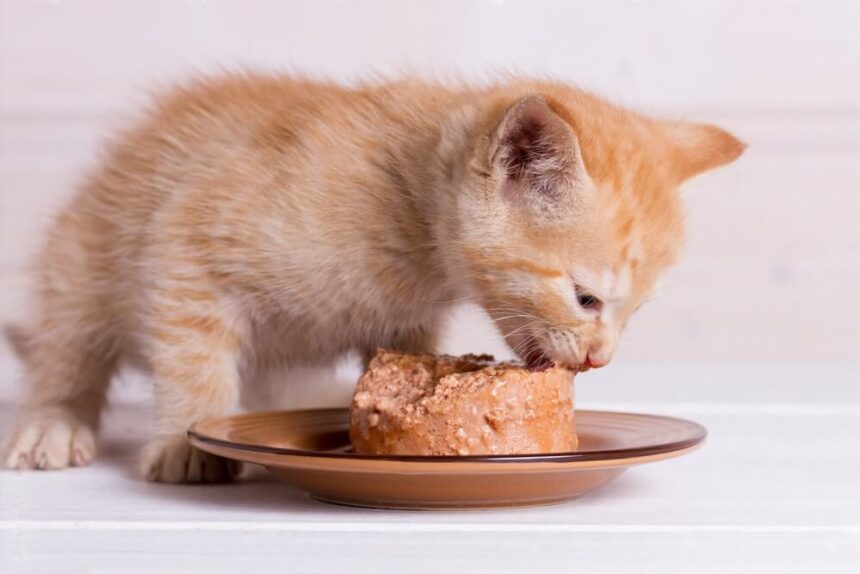If you’ve just welcomed a curious bundle of joy into your home, you probably wonder, “How to introduce wet food to kittens?“
Welcoming a new kitten into your home is a delightful experience, and ensuring they receive a balanced diet is crucial for their well-being.
One essential aspect is introducing wet food, which offers numerous benefits, including improved hydration and enhanced nutrient absorption.
However, this process can be challenging, requiring patience and a thoughtful approach.
As a seasoned cat parent, I’ll guide you through this crucial step in your little one’s nutritional journey. Let’s ensure a smooth transition to wet food for your adorable furball.
Why Wet Food?
Before diving into the how-tos, let’s talk about why wet food is a good choice for kittens. Wet food provides numerous benefits:
Hydration: Unlike dry food, wet food contains a high moisture content, which helps keep kittens hydrated.
Nutrient Absorption: Wet food often contains a higher level of proteins and essential nutrients that are easier for kittens to digest and absorb.
Palatability: Most kittens find wet food more appetizing due to its strong aroma and soft texture.
How To Introduce Wet Food To Kittens?
The process of introducing wet food to kittens isn’t always straightforward. Here’s a step-by-step guide to make the transition smooth and enjoyable for both you and your kitten.
Begin With a Teaser
Start by placing a small amount of wet food next to their regular dry food. This simple step introduces the new food’s texture and smell without overwhelming your kitten. They might sniff around or even give it a tentative lick, driven by their natural curiosity.
Watch Their Reaction
Kittens are naturally curious, and their reaction to the new food can be quite telling. Some might dive right in, while others might be more hesitant. Give them time and space to explore. If they seem disinterested, don’t force it. Instead, try again later.
Gradual Mixing
A gradual approach is often the most effective. Over several days, start mixing a small amount of wet food with their regular dry food. Gradually increase the proportion of wet food each day. This slow transition helps them get used to the new taste and texture without causing digestive upset.
Patience is Crucial
Transitioning to wet food can take time. Some kittens might take to it immediately, while others might need more time to adjust. Patience is key. Allow your kitten to set the pace and avoid rushing the process.
Age-Appropriate Choices
Make sure the wet food you choose is appropriate for your kitten’s age. Kitten-specific formulas are designed to meet their unique nutritional needs. Consult your veterinarian if you’re unsure about the best options for your kitten.
Optimal Serving Dish
The right serving dish can make a big difference. Use a shallow dish that makes it easy for your kitten to access the food. Avoid large portions that might seem intimidating. A small, manageable amount will encourage them to eat without feeling overwhelmed.
Positive Mealtime Experience
Creating a positive association with mealtime is crucial. Engage with your kitten during feeding times. Offer gentle encouragement and make it a pleasant experience. This can help foster a positive attitude towards wet food.
When can I start giving my kitten wet food?
You might be wondering when the best time to start introducing wet food to your kitten is. Generally, kittens are ready to begin sampling wet food around four weeks old. At this age, they’re still nursing or being bottle-fed with kitten formula, but a small amount of wet food can be introduced alongside their milk.
As they grow, you can gradually increase the amount and frequency of wet food. By the time they’re eight weeks old, wet food can become a regular part of their diet. Always consult with your veterinarian to ensure the timing aligns with your kitten’s individual needs.
Health Benefits of Wet Food
The benefits of wet food extend beyond just hydration and taste. Here are a few more reasons why wet food is a great choice for kittens:
Supports Dental Health: While dry food is often recommended for dental health, wet food can also play a role. The moisture content can help wash away food particles that might otherwise stick to their teeth.
Enhanced Nutrient Absorption: Wet food’s higher moisture content makes it easier for kittens to digest and absorb essential nutrients.
Weight Management: For kittens that are prone to overeating, wet food can be beneficial. Its higher water content means they can eat a larger portion without consuming too many calories.
Can 2-Week-Old Kittens Eat Wet Food?
At two weeks old, kittens are not yet ready for wet food. They rely on their mother’s milk or a suitable kitten formula for nutrition. Their digestive systems are still developing, and introducing wet food too early can cause digestive upset. Wait until they are at least four weeks old before starting the transition to wet food.
FAQs
You’re not alone in having questions about this transition. Here are some common questions and answers that might help:
What if My Kitten Refuses Wet Food?
It’s not uncommon for kittens to be hesitant at first. Keep trying with small amounts and different flavors. Mixing wet food with a bit of their favorite dry food can help.
How Often Should I Introduce New Flavors?
Introduce new flavors gradually. Give your kitten time to adjust to each new flavor before trying another. This helps avoid overwhelming their taste buds.
Can I Mix Wet and Dry Food?
Yes, mixing wet and dry food can provide a balanced diet. Just be mindful of portion sizes to avoid overfeeding.
Which Wet Food Brands are Best?
Consult with your veterinarian for recommendations tailored to your kitten’s specific needs. There are many high-quality brands available, but your vet can help you choose the best one.
Is it normal for my kitten to have loose stools during the transition?
Some loose stools might occur initially as your kitten’s digestive system adjusts. If it persists, consult your veterinarian.
Conclusion
Introducing wet food to kittens is a journey that requires patience and a thoughtful approach. By following these steps and tips, you’ll help your kitten adapt to wet food smoothly. Celebrate the small victories and always prioritize their comfort during this transition.
Remember, every kitten is unique, and what works for one might not work for another. Pay attention to your kitten’s cues and adjust the process accordingly. With time and persistence, you’ll find the right balance and ensure your furry friend enjoys the many benefits of wet food.



